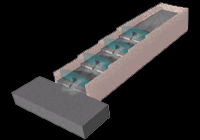| Narration | Tasks |

|
|
| The task of this tutorial is to use the model
provided with the tutorial to create an experiential narrative of form-making.
What do we mean by “an experiential narrative of form-making”? First the narrative part. Narratives are stories and you have been telling stories about your form-making in both words and pictures for nearly two terms now. A story flows through time and has a structure. A typical (though by no means the only) structure is to start with an introduction, develop the story and finish with a conclusion. Second, the experiential part. You are to present your work from the point-of-view of a human onlooker. You will create four perspective images, one each from the bottom of each of the sets of stairs in the model provided for this tutorial. The views are pre-defined as b1, b2, b3 & b4. Third, the form-making part. Unlike all previous work in this subject in which the experience you were creating and the story you were telling was of a design per se, in this tutorial you are to express a form-making idea in four stages as a principal part of your work. The model for this tutorial contains four light blue, transparent frames. You are to replace each of these frames with a form such that each successive form as you move towards the back of the site is a development of the previous one. The above would suggest one structure for your work. In the first
frame you introduce an idea, in the second two develop it and in the
final frame present it as a complete idea. If you adopt this stance,
a good way to start is to proceed backwards from the fourth completed
frame (you would thus |